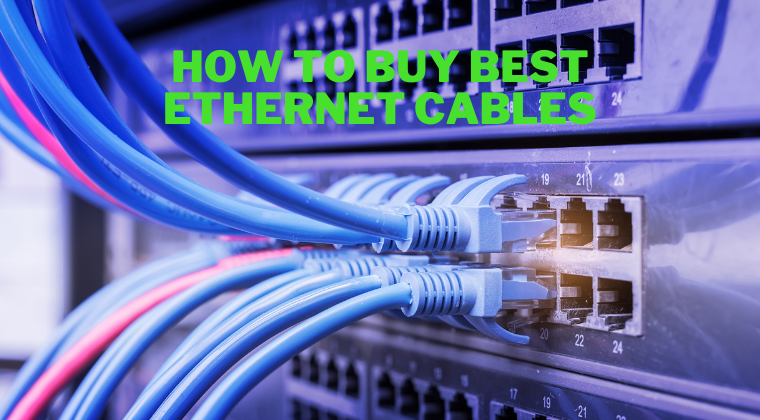Purchasing an Ethernet cable is not always as straightforward as it appears. In terms of network cables, there is a massive selection of different types, including cat5, cat5e, cat6, cat6a, Cat7 cables, and different lengths, colors, and other options. These can be obtained from a variety of different vendors and suppliers.
A network cable’s specification is critical: overspecify. You will pay too much, underspecify, and the performance will be impaired, resulting in the local area network or Ethernet link not functioning as efficiently or as effectively as it could.
By selecting the most appropriate Ethernet cable, you can ensure that the best possible performance is obtained at the lowest possible cost.
It is necessary to understand what is required to ensure that the best network cables for the system are purchased for it. It is worthwhile to take a few minutes to precisely determine what is needed and learn about the various Ethernet cable options currently available.
Aspects such as performance, price, availability, quality, and many others impact the final decision. Even though some are difficult to evaluate, knowing the facts can assist in making an informed decision about which Ethernet cable to purchase.
Ethernet Cable Requirements
Ethernet Cables are becoming increasingly common. Homes with broadband have routers that provide Wi-Fi and have the option of using Ethernet – typical routers for small offices or home local area networks often have four Ethernet ports. Those for larger offices will typically be dedicated Ethernet routers with Wi-Fi access points that can be placed wherever they are needed to meet the needs of the network. Because of the routers and additional switches, a significant increase in Ethernet cables will be required.
Although Wi-Fi is improving and providing significantly higher levels of performance, Ethernet is also improving. The network cables that are associated with it offer some distinct advantages in various situations. WLAN performance can be affected by several factors, including the location, any obstacles in the way, the distance between the router and the client, and many other factors. Ethernet cables provide a consistent level of performance and are frequently chosen for use in many offices. They can also be handy for home local area networks.
Compatibility
One of the advantages of Ethernet cables is that they are interchangeable and can be used in both forward and backward compatibility. The only real disadvantage of using an older type of cable, such as a Cat5, is that it will not support such high data transfer speeds.
It is possible to connect a Cat5 cable to a router with the latest 10G Ethernet interface using a Cat5e patch cable. It is only a problem that the cable will cause the data transfer to be slowed. Depending on the type of file transfers, this may or may not pose a problem.
Similarly, it is possible to connect a Cat7 cable to an older router that does not support the latest transmission speeds. And everything will function as expected.
This means that when purchasing an Ethernet cable, there is a great deal of flexibility; the worst-case scenario is that the network cable may cause a slight slowdown in performance.
Ethernet Cable Length
Ethernet cables are available in many different standard lengths. While it is possible to construct your cables, most people will prefer to use one of the pre-made cables available on the market.
Cables are widely available in a wide range of lengths: 0.5, 1, 1.5, 2, 5, 10, 20-meter measurements are all familiar, as are shorter distances. A wide variety of long Ethernet cables are readily available, with maximum lengths of approximately 75 meters being easily found. It is best to shop around if different cable lengths are required because a large selection is available. Various stockists will stock different cable lengths, some with a significantly more excellent choice than others.
When determining the length, make sure that the cable will be long enough to accommodate the height. Typically, a little slack is required because cables always appear to be needed to be longer than the very shortest lengths measured. Allow for a small amount of wiggle room, but not so much that a significant amount of cable length is consumed. Long Ethernet cables can be beneficial, but they can become a bit of a bad thing! Any excess length can be neatly looped together and secured with a cable tie if necessary.
When installing cable into a house in conjunction with another permanent wiring, cable in a reel will be purchased and terminated as needed to the appropriate sockets in the house. Reels of Ethernet cable can be purchased in lengths ranging from 100 meters to 500 meters or more.
Conclusion:
When purchasing Ethernet cables, the most crucial decision is which thread is the best fit for your needs. The performance benefit outweighs the cost.
Cat 5e cable is currently sufficient for most domestic applications, though in the coming years, as speeds continue to increase, they may be forced to limit them to prevent overheating. It is standard for the Internet connection to be the primary bottleneck. If you are not constantly transferring large files, Cat6 or Cat7 cable is unlikely to make a significant difference. All Ethernet equipment will support the higher speeds in any case, and any transfer will default to the lowest-speed component of the network regardless of connection.
Cat 6 and Cat 6a cables are a good choice if you want to be sure that you will receive the fastest possible speeds. They are often not significantly more expensive than Cat 5, and for future-proofing purposes, they are an excellent choice. Additionally, Cat5 is no longer in use, so it is best not to use it.
